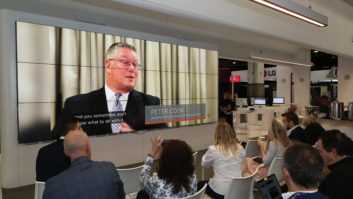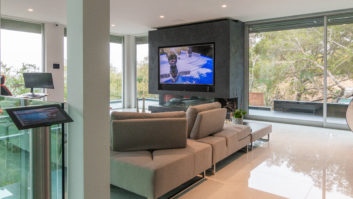Author and business consultant Peter Drucker once declared that, “the single most important thing to remember about any enterprise is that there are no results inside its walls. The result of a business is a satisfied customer.”
These days, however, a customer isn’t satisfied just because they bought a cool new toy.
“Over the last 10 to 15 years, it has become increasingly difficult for companies to differentiate themselves on product features alone,” noted Bob Hana, president of video products manufacturer Runco (www.runco.com). “Offering more comprehensive customer service has become critical to overall success.” In accordance with this viewpoint, Runco’s “World Premier Customer Service Program” includes factory training, 24-hour technical support and an expanded set of warranties.
While Drucker sums up the secret to successful commerce in a couple of clever lines, most businesspeople know how much hard work is required to keep customers happy-especially if one leads a company that deals in new, groundbreaking (and at times unpredictable) technology.
“Customers in general are more demanding, but the biggest problem is that the product has become so much more complicated and is, quite honestly, less reliable,” said Jay Trieber, president of Home Theater Concepts (www.hometheaterconcepts.com) a Norwood, Massachusetts, custom installation firm. “In general, the failure rate has increased as the cost of products get driven down by the marketplace. Something just gets cheaper in price and quality, so it’s going to fail more often.”
Which, from a customer’s perspective, isn’t their problem.
“When you are talking about home controls and automation systems, customers expect two things from us: one, that the software and interface is so simple that the system seems to be reading their minds, and it should do that every single time,” said Michael Holthouse, president of Intuitive Homes (www.intuitivehomes.com) a custom installation firm in Houston, Texas. If a customer is unable to get the system working, “that is our failure. Then we talk about what we did wrong, how to support it, how to prevent it from happening again, and then we get them back up and running,” he said.
Even though most customers may not want to hear it, technology by nature isn’t perfect. Holthouse accommodates this reality by ensuring that his team is proactive when it comes to troubleshooting problems. “Intuition”-a piece of code that Intuitive Homes integrates into the systems the firm installs-notifies technicians when there is a failure. “We are constantly getting feedback as to what is taking place, and its very likely that we are going to know about a failure before a customer does, so we can fix the problem before the customer even knew there was one,” he explained. “No one can build a system that will never have problems; the best you can do is to be proactive.”
Intuitive Homes also keeps system logs, which facilitate systems analysis during troubleshooting.
The prompt servicing of failed systems is the mark of solid customer service practices, but it does come at a cost; customers don’t expect to pay for the servicing of a $20,000 plasma television shortly after purchasing it. “The client expects that if they spend that much money it should never break, and there is logic in that,” Trieber admitted. “They want you to take it, fix it and bring it back.”
Those companies that demonstrate a willingness to do this separate themselves from businesses that don’t bother putting much effort into customer service. Joe Piccirilli, managing director of AVAD LLC (www.avad.com), a Hollywood, Florida-based distributor of Panasonic, Fujitsu, Sharp, Harman/Kardon, and others, is presented with two sets of customers that require servicing: its dealers, as well as its vendors. To bridge the gap between the two, AVAD offers an extensive training program that covers product knowledge, interoperability, as well as sales. AVAD also offers full-time application and technical support.
Reflecting on the state of customer service, in general, Piccirilli believes that consumers are being cheated. “Customer expectations have been continually beaten down,” he observed. “Customer expectations for service in almost any type of retailing now are so low that when they walk into a store and are greeted and acknowledged, they consider that to be great customer service.”
Piccirilli may not be working directly with end users, but his view on what customers want out of those who service them isn’t much different from those working in the field: “The expectation is that they are buying a solution, not a product,” he said. “They want to buy a home entertainment system and be able to make it work and have it work at all times. They need someone who will come into their home and make these systems simple and bulletproof.”
When homeowners purchase residential technology, they aren’t necessarily buying a set of components. To the end user, home theaters and distributed audio systems are more than the sum of their parts. “When you sell someone a list of products, that is what you are contractually obligated to provide,” Gerhardt said. “But what they are buying in their mind is the completed product, and that includes everything on the list and everything that it takes to make it work right-all of the management, cabling, software and training.”
Customers, for the most part, also do not wish to be inundated with product specifications. “I believe that part of the customer’s expectation is that they don’t want to choose,” Piccirilli noted. Instead, they want to tell an expert what they wish to accomplish and receive advice on how to achieve their goal. “That is where a huge void in the marketplace is being filled by custom installers, because traditional retailers have difficulty in doing that-especially when they are advertising item and price. When you advertise item and price, you are asking the customers to make their own choices,” Piccirilli added.
One of the most significant customer-related challenges that custom installation companies face is that when a project comes to a close, chances are your company is not going to be winning large amounts of business for a long time from them, even if the homeowner is elated with the service you provided. Nonetheless, Rob Gerhardt of Atlanta-based consulting firm Group Gerhardt, LLC (www.groupgerhardt.com), advises clients to utilize their existing customer base to cultivate new accounts. “The only way to succeed in our industry is to build a strong referral base,” he said. “What you really want to do is keep your existing customers aware of you so you can benefit from the people they know.” Oftentimes, remaining in touch with existing clients is as easy as sending an e-mail-based newsletter.
By generating business through referrals, companies are less likely to sell solely on price. “Otherwise, you are going to be struggling to find new clients, and when you find them you are going to be trying to make things easier to sell as opposed to easier to buy,” Gerhardt said. “You will be price-focused, which puts you in a diminishing position because the Internet allows everyone to buy products for less and less.”
Carolyn Heinze ([email protected]) works from her office in Vancouver, British Columbia, Canada.







